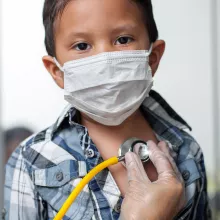Main navigation
7 results found



Adolescents and teens who have positive role models and who participate in after-school clubs tend to be more physically active and are less likely to be overweight, according to a study by the UCLA Center for Health Policy Research.
However, the research also found that low-income teens and teens of color are less likely to have this kind of positive support.
Using data from the 2011–12

Adolescents and teens who have positive role models and who participate in after-school clubs tend to be more physically active and are less likely to be overweight, according to a study by the UCLA Center for Health Policy Research.
However, the research also found that low-income teens and teens of color are less likely to have this kind of positive support.
Using data from the 2011–12

Got lots of fast food restaurants and other outlets that sell junk food in your neighborhood? Then your teen is more likely to nosh regularly on burgers and fries and wash them down with a soda.
That is the unpalatable finding of a new study from the UCLA Center for Health Policy Research that examined the effect of higher concentrations of less healthy food outlets on adolescent junk food consumption.

Got lots of fast food restaurants and other outlets that sell junk food in your neighborhood? Then your teen is more likely to nosh regularly on burgers and fries and wash them down with a soda.
That is the unpalatable finding of a new study from the UCLA Center for Health Policy Research that examined the effect of higher concentrations of less healthy food outlets on adolescent junk food consumption.

Despite a state requirement that public middle and high school students get 400 minutes of physical education every 10 days, approximately 1.3 million teens — more than a third (38 percent) of all adolescents enrolled in California public schools — do not participate in any school-based physical education classes, according to a new policy brief from the UCLA Center for Health Policy Research.

Despite a state requirement that public middle and high school students get 400 minutes of physical education every 10 days, approximately 1.3 million teens — more than a third (38 percent) of all adolescents enrolled in California public schools — do not participate in any school-based physical education classes, according to a new policy brief from the UCLA Center for Health Policy Research.

Although recent research has shown that obesity rates are leveling off among children generally, a new study published in the American Journal of Public Health finds that obesity prevalence significantly increased among lower-income California teens between 2001 and 2007.

Although recent research has shown that obesity rates are leveling off among children generally, a new study published in the American Journal of Public Health finds that obesity prevalence significantly increased among lower-income California teens between 2001 and 2007.



The result: low-income teenagers are almost three times more likely to be obese than teens from more affluent households, according to new research from the UCLA Center for Health Policy Research.

The result: low-income teenagers are almost three times more likely to be obese than teens from more affluent households, according to new research from the UCLA Center for Health Policy Research.













